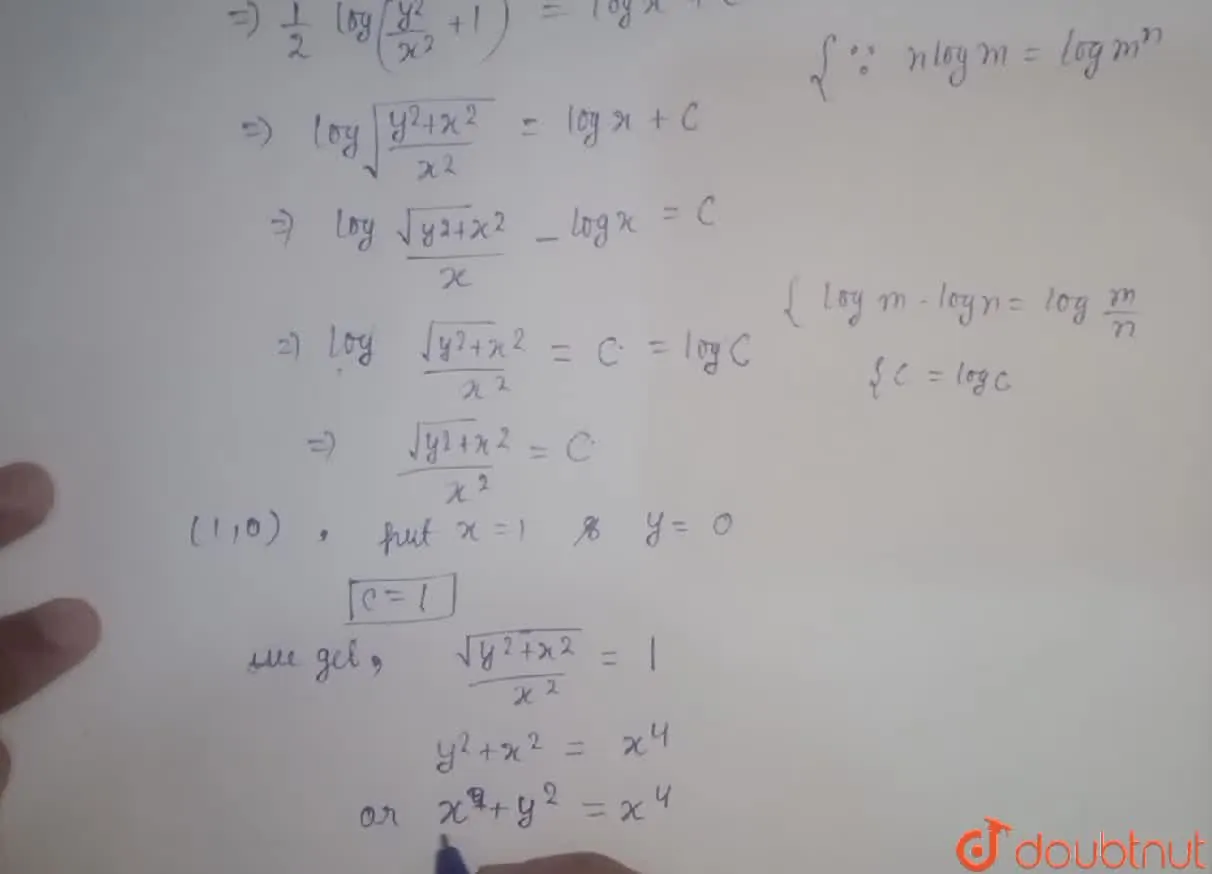The equation of a curve passing through (1,0) for which the product of the abscissa of a point P and the intercept made by a normal at P on the x-axis equal twice the square of the radius vector of the point P is (a) (b)(c)(d)x(e)2(f)(g)+(h)y(i)2(j)(k)=(l)x(m)4(n)(o)(p) (q) (b) (r)(s)(t)x(u)2(v)(w)+(x)y(y)2(z)(aa)=2(bb)x(cc)4(dd)(ee)(ff) (gg) (c) (d)(e)(f)x(g)2(h)(i)+(j)y(k)2(l)(m)=4(n)x(o)4(p)(q)(r) (s) (d) None of these
x2+y2=x4
x2+y2=2x4
x2+y2=4x4
None of these
The correct Answer is:A
Tangent at point P is Y−y=−1m(X−x) where m=dydx
Let Y=0, Then X=my+x
 According to question, x(my+x)=2(x2+y2)
According to question, x(my+x)=2(x2+y2)
or dydx=x2+2y2xy (homogenous)
Putting y=vx we get
v=xdvdx=1+2v2v
or xdvdx=1+2v2v
xdvdx=1+2v2v−v=1+v2v
or ∫vdv1+v2=∫dxx
or 12log(1+v2)=logx+logc,c>0
or x2+y2=cx4
Also, it passes through (1,0). Then c=1.
Related Playlists
- BOOK - CENGAGE ENGLISHCHAPTER - DIFFERENTIAL EQUATIONSEXERCISE - MULTIPLE CORRECT ANSWERS TYPE17videos
DIFFERENTIAL EQUATIONS
- BOOK - CENGAGE ENGLISHCHAPTER - DIFFERENTIAL EQUATIONSEXERCISE - Linked Comprehension types21videos
DIFFERENTIAL EQUATIONS
- BOOK - CENGAGE ENGLISHCHAPTER - DIFFERENTIAL EQUATIONSEXERCISE - CONCEPT APPLICATION EXERCISES 10.95videos
DIFFERENTIAL EQUATIONS
- BOOK - CENGAGE ENGLISHCHAPTER - DIFFERENT PRODUCTS OF VECTORS AND THEIR GEOMETRICAL APPLICATIONS EXERCISE - Multiple correct answers type11videos
DIFFERENT PRODUCTS OF VECTORS AND THEIR GEOMETRICAL APPLICATIONS
- BOOK - CENGAGE ENGLISHCHAPTER - DIFFERENTIATIONEXERCISE - Archives14videos
DIFFERENTIATION
Similar Questions
Solution of dydx+2xy=y is (a) (b)(c)y=c(d)ee(f)x−(g)x((h)2(i))(j)(k)(l)(m) (n) (b) (o)(p)y=c(q)er(s)(t)x((u)2(v))(w)−x(x)(y)(z) (aa) (c) (d)(e)y=c(f)e(g)x(h)(i)(j) (k) (d) (l)(m)y=c(n)eo(p)−(q)x((r)2(s))(t)(u)(v)(w) (x)
View SolutionThe differential equation of all non-horizontal lines in a plane is (a) (b)(c)(d)(e)(f)d(g)2(h)(i)yj((k)d(l)x(m)2(n)(o))(p)(q)(r) (s) (b) (t)(u)(v)(w)(x)d(y)2(z)(aa)xbb((cc)d(dd)y(ee)2(ff)(gg))(hh)(ii)=0(jj) (kk) (c) (d)(e)(f)(g)dyh((i)dx)(j)(k)=0(l) (m) (d) (n)(o)(p)(q)dxr((s)dy)(t)(u)=0(v) (w)
View SolutionThe solution of the differential equation (x2y2−1)dy+2xy3dx=0 is (a) (b)(c)1+(d)x(e)2(f)(g)(h)y(i)2(j)(k)=cx(l) (m) (b) (n)(o)1+(p)x(q)2(r)(s)(t)y(u)2(v)(w)=cy(x) (y) (c) (d)(e)y=0(f) (g) (d) (h)(i)y=−(j)1k((l)(m)x(n)2(o)(p))(q)(r)(s) (t)
View SolutionThe equation of the curves through the point (1, 0) and whose slope is y−1x2+x is (a) (b)(c)((d)(e)y−1(f))((g)(h)x+1(i))+2x=0(j) (k) (l) (m)(n)2x((o)(p)y−1(q))+x+1=0(r) (s) (t) (u)(v)x((w)(x)y−1(y))((z)(aa)x+1(bb))+2=0(cc) (dd) (ee)None of these
View SolutionA curve passing through (2,3) and satisfying the differential equation ∫x0ty(t)dt=x2y(x),(x>0) is (a) (b)(c)(d)x(e)2(f)(g)+(h)y(i)2(j)(k)=13(l) (m) (b) (n)(o)(p)y(q)2(r)(s)=(t)9u2(v)(w)x(x) (y) (c) (d)(e)(f)(g)(h)x(i)2(j)(k)l8(m)(n)+(o)(p)(q)y(r)2(s)(t)u((v)18)(w)(x)=1(y) (z) (d) ( a a ) (bb) x y=6( c c ) (dd)
View SolutionA curve is such that the mid-point of the portion of the tangent intercepted between the point where the tangent is drawn and the point where the tangent meets the y-axis lies on the line y=x. If the curve passes through (1,0), then the curve is (a) (b)(c)2y=(d)x(e)2(f)(g)−x(h) (i) (b) (j)(k)y=(l)x(m)2(n)(o)−x(p) (q) (c) (d)(e)y=x−(f)x(g)2(h)(i)(j) (k) (d) (l)(m)y=2((n)(o)x−(p)x(q)2(r)(s)(t))(u) (v)
View SolutionFind the equation of a curve passing through the point (1.1) if the perpendicular distance of the origin from the normal at any point P(x, y) of the curve is equal to the distance of P from the x-axis.
View SolutionFind the equation of the curve passing through the point, (5,4) if the sum of reciprocal of the intercepts of the normal drawn at any point P(x,y) on it is 1.
View SolutionIf x(t) is a solution of (1+t)dydx−ty=1 and y(0)=−1 then y(1) is (a) (b)(c)−(d)1e2(f)(g)(h) (i) (b) (j)(k)e+(l)1m2(n)(o)(p) (q) (c) (d)(e)e−(f)1g2(h)(i)(j) (k) (d) (l)(m)(n)1o2(p)(q)(r) (s)
View SolutionShow that the equation of the curve passing through the point (2,1) and for which the sum of the subtangent and the abscissa is equal to 1 is y(x−1)=1.
View Solution


